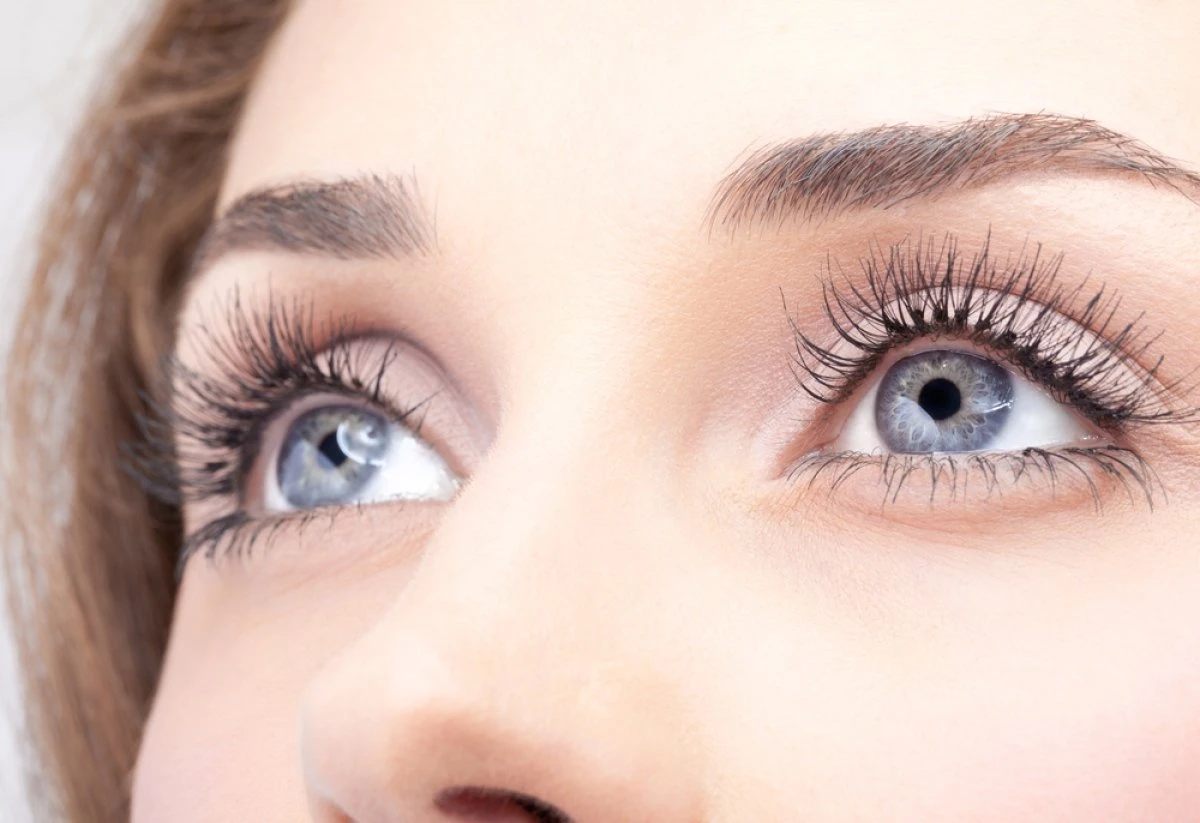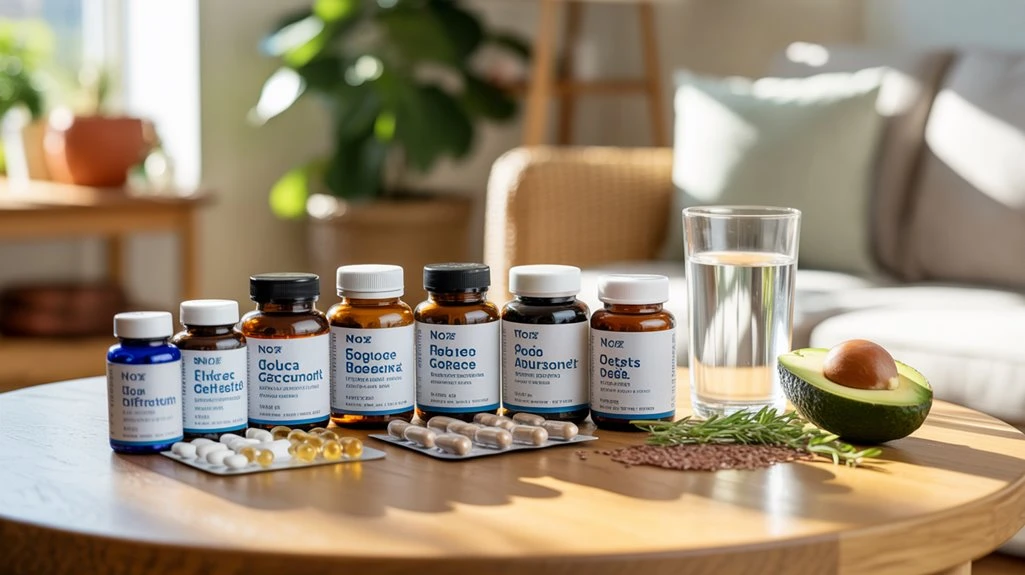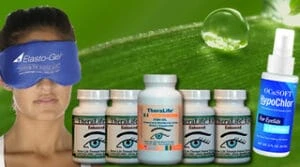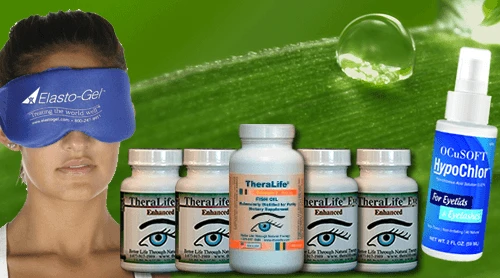TheraLife’s unique approach to eye care sets it apart as the only company offering oral treatment solutions specifically designed for dry eyes. Their products are formulated to target various eye conditions by promoting tear film stability and ocular surface integrity. Key supplements include omega-3 fatty acids for supporting eye health, vitamin A for maintaining epithelial integrity, and vitamin D for its anti-inflammatory properties. Additionally, TheraLife incorporates vitamin C for antioxidant protection, gamma-linolenic acid (GLA) for tear film stabilization, lutein and zeaxanthin for reducing oxidative stress, and zinc for tissue repair and tear production. By addressing these distinct mechanisms, TheraLife’s products provide comprehensive relief for dry eye symptoms, ensuring optimal eye health for their customers.
Best Oral Dry Eyes Treatment That Works .
Add To Cart
Key Takeaways- Dry Eyes
- Gamma-linolenic acid (GLA) from evening primrose or borage oil can reduce dry eye symptoms by supporting tear production and decreasing inflammation.
- Vitamin A supplementation helps maintain ocular surface health and mucin production, especially in cases of deficiency.
- Vitamin D supports tear film stability and reduces ocular surface inflammation, alleviating dry eye discomfort.
- Lutein and zeaxanthin, as antioxidants, protect ocular tissues and help reduce oxidative stress affecting the tear film.
- Zinc is essential for tear production, ocular surface repair, and immune modulation, making it beneficial for dry eyes when deficient.
Omega-3 Fatty Acids – in Dry Eyes

Several clinical trials have assessed the impact of omega-3 fatty acids on dry eye symptoms, but current evidence doesn’t support their effectiveness in treating this condition.
You might find omega-3 sources such as fish oil, flaxseed oil, and algal oil promoted for ocular surface health. However, randomized controlled studies, including the DREAM trial, demonstrate no significant improvement in dry eye signs or symptoms with omega-3 supplementation compared to placebo.
Although omega 3 dosage recommendations often range from 1000 to 3000 mg daily for general health, these regimens haven’t shown consistent benefits specifically for dry eye management.
Given the lack of proven efficacy, you shouldn’t rely on omega-3 fatty acids as a primary intervention for dry eye disease. Focus on evidence-based therapies instead. Omega-3s, particularly DHA, are essential fatty acids that contribute to overall health and cell function, though their role in treating dry eye remains inconclusive.
Vitamin A In Dry Eyes
Vitamin A plays a critical role in maintaining the health of the ocular surface and supporting proper tear film production. If you’re managing dry eyes, ensuring adequate vitamin A intake is essential for epithelial integrity and ideal mucin production within the tear film.
Clinical studies demonstrate that vitamin A deficiency can lead to xerophthalmia, a condition characterized by severe dryness and compromised corneal function. You’ll find several vitamin A benefits for eye health, including reduced ocular surface inflammation and improved epithelial healing.
Consider these key points:
- Vitamin A supports conjunctival and corneal epithelial cell differentiation.
- It enhances mucin secretion, stabilizing tear film.
- Deficiency increases risk of keratinization and dry eye symptoms.
- Vitamin A sources include liver, dairy, eggs, and colorful vegetables (carrots, spinach).
An imbalance in tear production is a key factor in dry eye conditions, making vitamin A’s role in supporting tear film stability crucial for those suffering from this condition.
Vitamin D In Dry Eyes
You should know that vitamin D plays a critical role in supporting normal tear production and maintaining ocular surface integrity. Research indicates its anti-inflammatory properties may help reduce symptoms associated with dry eye disease. If you’re deficient in vitamin D, your risk for developing or worsening dry eye increases. Additionally, incorporating Omega-3 Fish Oil Benefits can help thicken natural tears and prevent evaporation, further alleviating dry eye symptoms.
Role in Tear Production
Recent research indicates that vitamin D doesn’t play a direct role in stimulating tear production. While you might encounter claims suggesting otherwise, current evidence consistently shows no direct impact of vitamin D on the mechanisms responsible for tear secretion or the maintenance of tear film stability and hydration balance. Instead, the primary functions of vitamin D in ocular health relate to pathways outside of basic tear production. Here’s what you should understand about vitamin D and tear production:
- Vitamin D doesn’t directly increase aqueous or lipid tear output.
- Its influence on hydration balance in the eye is indirect and limited.
- There’s no current evidence supporting vitamin D as a stimulator of tear film secretion.
- Supplementing with vitamin D won’t address tear deficiency due to lacrimal gland dysfunction.
- Psychological associations suggest that mental health support can enhance treatment outcomes for dry eyes.
Anti-Inflammatory Benefits
Although vitamin D doesn’t directly affect tear production, its relevance to dry eye disease primarily centers on its anti-inflammatory properties. When you have dry eye, inflammation on the ocular surface can exacerbate discomfort and slow healing. Vitamin D is recognized for modulating immune responses and reducing pro-inflammatory cytokines, making it a valuable addition to natural remedies for symptom relief. Clinical studies suggest that adequate vitamin D levels can help decrease ocular surface inflammation and improve overall eye comfort. Patients with chronic dry eye syndrome often report significant discomfort and the need for comprehensive management to address symptoms effectively. Consider the following key points:
| Benefit | Clinical Relevance |
|---|---|
| Reduces pro-inflammatory cytokines | Lessens ocular surface irritation |
| Modulates immune response | Stabilizes tear film environment |
| Supports natural remedies | Enhances non-pharmacologic options |
| Improves eye comfort | Diminishes chronic discomfort |
| Complements other therapies | Strengthens thorough care |
Deficiency and Eye Health
Several clinical investigations have established a correlation between vitamin D deficiency and increased risk of dry eye disease.
When your body lacks sufficient vitamin D, it compromises essential processes that protect ocular surface integrity and tear film stability. This deficiency negatively impacts both eye nutrition and visual wellness.
To understand how low vitamin D levels can impair ocular health, consider these evidence-based mechanisms:
- Vitamin D modulates immune response, reducing ocular surface inflammation.
- It promotes epithelial barrier function, vital for maintaining tear film balance.
- Deficiency correlates with increased tear osmolarity, a hallmark of dry eye pathology.
- Adequate vitamin D enhances lacrimal gland function, supporting sustained tear production.
When dealing with chronic dry eyes, it is crucial to explore treatments that address underactive tear production, which is often a root cause of the condition.
Vitamin C In Dry Eyes

Vitamin C, an essential antioxidant, plays a key role in immune function and collagen synthesis, but current clinical evidence doesn’t support its use as an effective supplement for alleviating dry eye symptoms. While vitamin C benefits include supporting ocular surface health and protecting against oxidative stress, studies haven’t demonstrated a direct therapeutic effect on dry eye disease. You’ll find vitamin C sources in citrus fruits, berries, peppers, and leafy greens, making dietary intake straightforward for most individuals. Although adequate intake is crucial for general eye health and tissue repair, supplementing specifically for dry eye isn’t evidence-based at this time. If you consider vitamin C supplementation, focus on maintaining recommended dietary levels rather than exceeding them for dry eye relief, as higher doses haven’t shown added benefit. Chronic dry eyes can result from various factors, including autoimmune diseases and certain medications, making it important to understand underlying causes for effective management.
GLA (Gamma-Linolenic Acid) In Dry Eyes
Unlike vitamin C, GLA (gamma-linolenic acid) has shown more promising results in clinical studies related to dry eye management.
You’ll find that GLA benefits include supporting tear production, reducing ocular surface inflammation, and stabilizing the lipid layer of the tear film. GLA sources primarily include plant-based oils such as evening primrose oil, borage oil, and black currant seed oil. Supplementation can be especially valuable if your diet lacks these sources.
TheraLife Omega-3, known for its molecular distillation process, ensures high purity and potency, which can complement GLA supplementation in managing dry eye symptoms.
Here’s how GLA can help with dry eye symptoms:
- Enhances meibomian gland function, improving lipid secretion.
- Decreases pro-inflammatory mediators on the ocular surface.
- Increases tear volume and stability.
- Reduces subjective symptoms of dryness and irritation.
If you’re considering supplements, prioritize those with clinically effective GLA concentrations for best results.
Lutein and Zeaxanthin In Dry Eyes
While best known for their role in supporting macular health, lutein and zeaxanthin also contribute to ocular surface integrity. These carotenoids act as potent antioxidants within the eye, helping to reduce oxidative stress that can compromise tear film stability and epithelial health. Clinical research shows that consistent intake of lutein benefits those experiencing dry eye symptoms by enhancing the eye’s natural defenses against environmental strain. You’ll find zeaxanthin sources in leafy greens like kale and spinach, as well as in egg yolks and corn. Supplementation can help maintain adequate carotenoid levels, especially if your dietary intake is insufficient. For those seeking additional relief, TheraLife Eye capsules aim to revive and restore natural tear production, offering a potential solution for chronic dry eye sufferers.
Zinc

You need adequate zinc to support ideal eye health, as it’s essential for vitamin A metabolism and retinal function. If you’re deficient, you might experience impaired night vision or increased risk of ocular surface changes. To maintain proper levels, focus on dietary sources like oysters, beef, and legumes, and follow recommended dosage guidelines to avoid toxicity. For those with autoimmune conditions, TheraLife Autoimmune may also provide relief from dry eye symptoms while aiding in improving moisture levels.
Role in Eye Health
Zinc is an essential trace mineral involved in numerous enzymatic processes throughout the body, including ocular tissue maintenance and function.
When you consider eye health, zinc plays several evidence-based roles that directly influence both eye hydration and visual acuity. Its multifaceted actions include:
- Supporting the metabolism of vitamin A, which is critical for ideal tear production and retinal health.
- Facilitating antioxidant defenses within ocular tissues, helping to mitigate oxidative stress that can compromise eye hydration.
- Enhancing cellular repair in the cornea and conjunctiva, ensuring the structural integrity needed for clear vision.
- Modulating immune responses in the eye, reducing inflammation that may exacerbate dryness or discomfort.
With these functions, zinc proves integral to maintaining the delicate balance of ocular surface health, supporting both moisture retention and sharp vision.
Zinc Deficiency Symptoms
A lack of adequate zinc disrupts several ocular processes, often leading to symptoms that signal compromised eye health.
If you’re experiencing persistent dry eyes, frequent eye irritation, or delayed wound healing on the ocular surface, these could indicate a zinc deficiency.
Zinc plays an essential role in maintaining the integrity of the retina and the function of enzymes critical to tear production.
Inadequate zinc absorption diminishes these protective mechanisms, potentially worsening discomfort and visual disturbances.
You might also notice increased sensitivity to light or impaired night vision, further pointing to insufficient zinc status.
Recognizing these symptoms can prompt timely evaluation and intervention.
Clinical evidence supports that correcting zinc deficiency, often through targeted zinc supplementation, can restore ocular surface health and relieve dry eye symptoms.
Dietary Sources and Dosage
Several nutrient-rich foods support ideal zinc intake essential for ocular health. To meet dietary recommendations, you should prioritize natural sources before considering supplementation guidelines.
Incorporating these zinc-rich foods into your daily regimen helps maintain healthy tear production and supports overall eye function:
- Oysters: The richest dietary source, offering considerably more zinc per serving than other foods.
- Lean meats and poultry: Beef, pork, and chicken provide moderate zinc content and are widely accessible.
- Legumes: Lentils, chickpeas, and beans supply zinc, especially important if you follow a plant-based diet.
- Nuts and seeds: Pumpkin seeds, cashews, and almonds contribute to daily zinc requirements.
Adults generally require 8–11 mg of zinc daily.
If dietary intake is insufficient, follow evidence-based supplementation guidelines to avoid excessive intake and potential adverse effects.
Best Oral Dry Eyes Treatment That Works
Add To Cart
Frequently Asked Questions In Dry Eyes
Are There Any Side Effects to Taking Dry Eye Supplements Long-Term?
When you take dry eye supplements, long term safety depends on the ingredients and adherence to dosage recommendations.
Omega-3 fatty acids, for example, are generally well-tolerated, but high doses may increase bleeding risk or cause gastrointestinal upset.
Excess vitamin A can be toxic.
Always consult your healthcare provider, as they’ll assess interactions, monitor for adverse reactions, and help guarantee you’re using evidence-based, safe dosages tailored to your specific health profile.
Can Children Safely Use Supplements for Dry Eyes?
You might worry about giving supplements to kids, but when you focus on children’s eye health, safety comes first.
Research shows that certain supplements, like omega-3 fatty acids, may support eye lubrication, but children’s safe dosage differs from adults.
Always consult a pediatric ophthalmologist before starting any supplement, as evidence-based guidelines guarantee you avoid adverse effects.
Never exceed recommended amounts, and monitor for reactions to maintain ideal children’s eye health and comfort.
How Soon Can I Expect Results From Dry Eye Supplements?
When you start dry eye supplements, the expected timeline for symptom improvement typically ranges from several weeks to three months.
Clinical studies indicate that nutrients like omega-3 fatty acids may take at least 4 to 8 weeks to greatly impact tear quality and ocular surface health.
You shouldn’t expect immediate relief; instead, monitor your symptoms regularly, and consult your eye care professional to assess progress and adjust supplementation if needed.
Do Supplements Interact With Prescription Eye Drops or Medications?
When considering supplement interactions, you should consult your healthcare provider before combining supplements with prescription eye drops or systemic medications.
Certain supplements, like omega-3 fatty acids or herbal products, can influence medication efficacy or increase the risk of side effects.
Clinical evidence highlights potential interactions with anticoagulants, antihypertensives, or immunosuppressants.
Your clinician can assess any risks and adjust your treatment plan to guarantee maximum safety and therapeutic effectiveness.
Are There Vegan or Vegetarian Supplement Options for Dry Eyes?
Steering through supplement choices for dry eyes can feel like finding a lighthouse in a fog.
You’ll find several plant based options and natural alternatives that fit vegan or vegetarian lifestyles.
Clinical evidence points to vegan omega-3 supplements sourced from algae, which provide essential fatty acids similar to fish oil.
Additionally, vegan capsules containing flaxseed oil, evening primrose oil, or astaxanthin offer precise, evidence-based support for ocular surface hydration without animal-derived ingredients.
Best Oral Dry Eyes Treatment That Works
Add To Cart
Conclusion In Dry Eyes
To effectively manage dry eyes and relieve discomfort, TheraLife offers a unique approach with its oral eye treatment care products. As the only company providing such a solution, TheraLife targets dry eyes from multiple angles, ensuring comprehensive ocular health. Their products incorporate omega-3 fatty acids, vitamin A, vitamin D, vitamin C, GLA, lutein, zeaxanthin, and zinc, each playing a critical role in reducing inflammation, supporting tear production, and protecting ocular tissues. By choosing TheraLife, customers can benefit from an evidence-based, multi-faceted approach to dry eye management, promoting long-term eye health. Consult with an eye care professional to explore the benefits of TheraLife’s products and take proactive steps towards comfort and wellness.
References
- 1.
- The definition and classification of dry eye disease: report of the Definition and Classification Subcommittee of the International Dry Eye WorkShop (2007). Ocul Surf. 2007 Apr;5(2):75-92. [PubMed]
- 2.
- Huang R, Su C, Fang L, Lu J, Chen J, Ding Y. Dry eye syndrome: comprehensive etiologies and recent clinical trials. Int Ophthalmol. 2022 Oct;42(10):3253-3272. [PMC free article] [PubMed]
- 3.
- Craig JP, Nichols KK, Akpek EK, Caffery B, Dua HS, Joo CK, Liu Z, Nelson JD, Nichols JJ, Tsubota K, Stapleton F. TFOS DEWS II Definition and Classification Report. Ocul Surf. 2017 Jul;15(3):276-283. [PubMed]
- 4.
- King-Smith PE, Fink BA, Hill RM, Koelling KW, Tiffany JM. The thickness of the tear film. Curr Eye Res. 2004 Oct-Nov;29(4-5):357-68. [PubMed]
- 5.
- King-Smith PE, Fink BA, Fogt N, Nichols KK, Hill RM, Wilson GS. The thickness of the human precorneal tear film: evidence from reflection spectra. Invest Ophthalmol Vis Sci. 2000 Oct;41(11):3348-59. [PubMed]
- 6.
- Chen Q, Wang J, Tao A, Shen M, Jiao S, Lu F. Ultrahigh-resolution measurement by optical coherence tomography of dynamic tear film changes on contact lenses. Invest Ophthalmol Vis Sci. 2010 Apr;51(4):1988-93. [PMC free article] [PubMed]
- 7.
- Willcox MDP, Argüeso P, Georgiev GA, Holopainen JM, Laurie GW, Millar TJ, Papas EB, Rolland JP, Schmidt TA, Stahl U, Suarez T, Subbaraman LN, Uçakhan OÖ, Jones L. TFOS DEWS II Tear Film Report. Ocul Surf. 2017 Jul;15(3):366-403. [PMC free article] [PubMed]
- 8.
- Peng CC, Cerretani C, Braun RJ, Radke CJ. Evaporation-driven instability of the precorneal tear film. Adv Colloid Interface Sci. 2014 Apr;206:250-64. [PubMed]
- 9.
- Zhou L, Beuerman RW. Tear analysis in ocular surface diseases. Prog Retin Eye Res. 2012 Nov;31(6):527-50. [PubMed]
- 10.
- Mantelli F, Mauris J, Argüeso P. The ocular surface epithelial barrier and other mechanisms of mucosal protection: from allergy to infectious diseases. Curr Opin Allergy Clin Immunol. 2013 Oct;13(5):563-8. [PMC free article] [PubMed]
- 11.
- O’Neil EC, Henderson M, Massaro-Giordano M, Bunya VY. Advances in dry eye disease treatment. Curr Opin Ophthalmol. 2019 May;30(3):166-178. [PMC free article] [PubMed]
- 12.
- Fjaervoll K, Fjaervoll H, Magno M, Nøland ST, Dartt DA, Vehof J, Utheim TP. Review on the possible pathophysiological mechanisms underlying visual display terminal-associated dry eye disease. Acta Ophthalmol. 2022 Dec;100(8):861-877. [PMC free article] [PubMed]
- 13.
- Craig JP, Nelson JD, Azar DT, Belmonte C, Bron AJ, Chauhan SK, de Paiva CS, Gomes JAP, Hammitt KM, Jones L, Nichols JJ, Nichols KK, Novack GD, Stapleton FJ, Willcox MDP, Wolffsohn JS, Sullivan DA. TFOS DEWS II Report Executive Summary. Ocul Surf. 2017 Oct;15(4):802-812. [PubMed]
- 14.
- Qian L, Wei W. Identified risk factors for dry eye syndrome: A systematic review and meta-analysis. PLoS One. 2022;17(8):e0271267. [PMC free article] [PubMed]
- 15.
- I Y Hasan ZA. Dry eye syndrome risk factors: A systemic review. Saudi J Ophthalmol. 2021 Apr-Jun;35(2):131-139. [PMC free article] [PubMed]
- 16.
- Paulsen AJ, Cruickshanks KJ, Fischer ME, Huang GH, Klein BE, Klein R, Dalton DS. Dry eye in the beaver dam offspring study: prevalence, risk factors, and health-related quality of life. Am J Ophthalmol. 2014 Apr;157(4):799-806. [PMC free article] [PubMed]
- 17.
- Chang CJ, Somohano K, Zemsky C, Uhlemann AC, Liebmann J, Cioffi GA, Al-Aswad LA, Lynch SV, Winn BJ. Topical Glaucoma Therapy Is Associated With Alterations of the Ocular Surface Microbiome. Invest Ophthalmol Vis Sci. 2022 Aug 02;63(9):32. [PMC free article] [PubMed]
- 18.
- Andole S, Senthil S. Ocular Surface Disease and Anti-Glaucoma Medications: Various features, Diagnosis, and Management Guidelines. Semin Ophthalmol. 2023 Feb;38(2):158-166. [PubMed]
- 19.
- Sobolewska B, Schaller M, Zierhut M. Rosacea and Dry Eye Disease. Ocul Immunol Inflamm. 2022 Apr 03;30(3):570-579. [PubMed]
- 20.
- Bilgic AA, Kocabeyoglu S, Dikmetas O, Tan C, Karakaya J, Irkec M. Influence of video display terminal use and meibomian gland dysfunction on the ocular surface and tear neuromediators. Int Ophthalmol. 2023 May;43(5):1537-1544. [PubMed]





